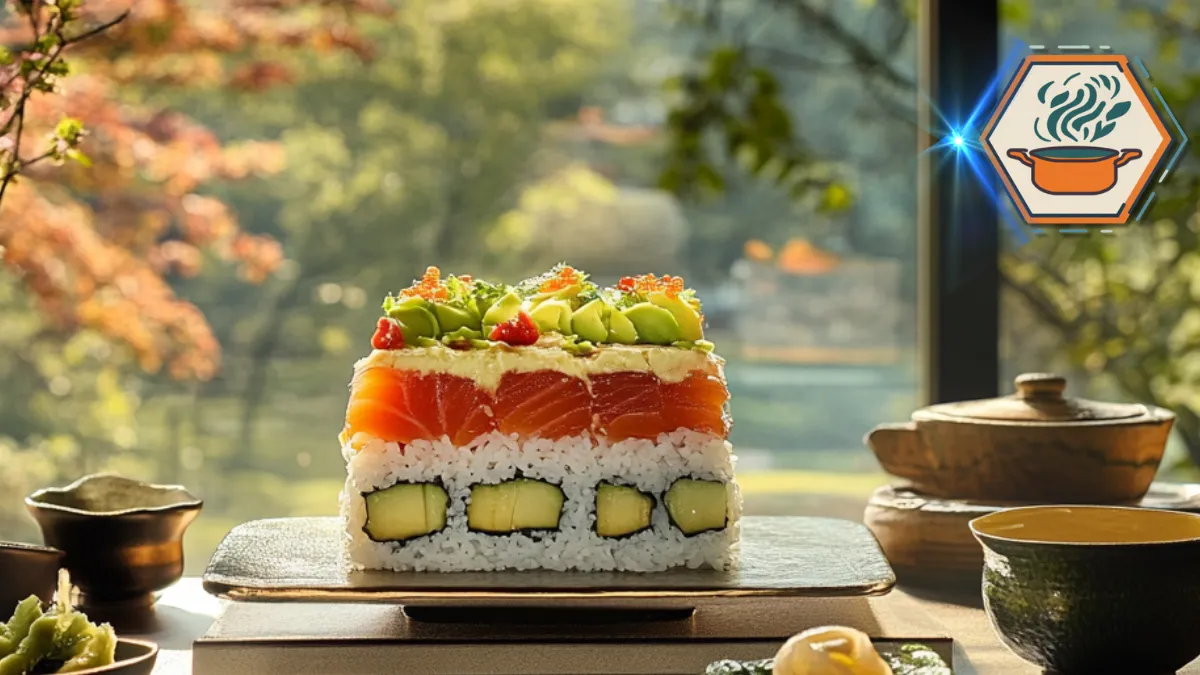Time to read:11 minutes
Table of Contents
Understanding Sushi Cakes
Sushi cakes are an exciting twist on traditional sushi, combining the flavors of sushi with a layered, cake-like presentation. What is sushi cake made of? It starts with layers of sushi rice, seaweed, and toppings like fish, vegetables, and more. These beautiful dishes are perfect for sharing, especially at celebrations.
Introduction to Sushi Cakes
Sushi cakes offer a creative way to enjoy sushi. They stack ingredients like sushi rice, seafood, and vegetables into a form resembling a cake. This method not only looks impressive but also makes it easier to serve for groups. Unlike traditional sushi rolls, sushi cakes allow for more customization of layers and toppings.
Many people choose Sushi cake recipe for their visual appeal. Additionally, they are versatile and suit many occasions, such as parties or family dinners. Moreover, the recipe is adaptable to different tastes, whether you prefer classic Japanese ingredients or modern flavors.
If you’re curious about unique sushi variations, visit our guide to what does a tempura roll have in it?.
Key Ingredients in Sushi Cakes
To understand what is sushi cake made of, it’s essential to explore its core components: the base, protein, vegetables, and garnishes. Each part contributes to the dish’s flavor and structure.
Base Layers: Sushi Rice and Seaweed
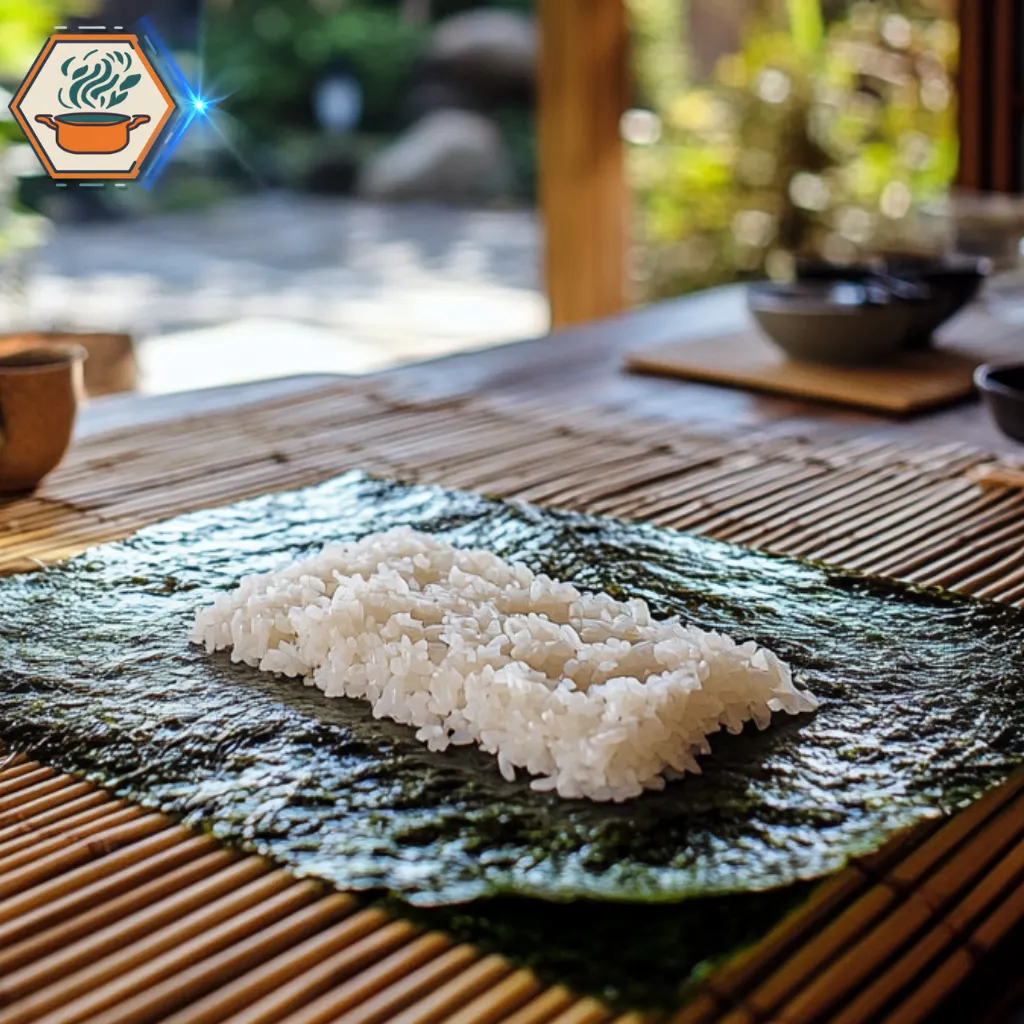
The base of a sushi cake uses sushi rice, which provides the necessary structure. This short-grain rice is seasoned with vinegar, sugar, and salt to achieve its signature flavor. Its stickiness is crucial for keeping the layers intact.
- Sushi Rice: The primary ingredient that supports the layers. After cooking, the rice is cooled before use.
- Seaweed (Nori): This layer adds a savory taste and strengthens the base.
Some prefer using egg crepes instead of seaweed to soften the texture. This alternative works especially well for children or individuals who like milder flavors.
Protein Options: Fish, Tofu, and More
Proteins add depth and nutrition to sushi cakes. Depending on your preference, you can select:
- Raw Fish: Slices of salmon or tuna for a traditional option.
- Cooked Seafood: Shrimp, crab, or smoked salmon make excellent alternatives.
- Vegetarian Choices: Tofu or marinated mushrooms provide plant-based options.
High-quality seafood ensures better flavor and safety. Always choose fresh ingredients and follow guidelines for seafood preparation. To learn more, consult this FDA updates seafood-safety guidelines
Vegetables and Garnishes
Vegetables and garnishes enhance both the taste and appearance of sushi cakes. These ingredients add vibrant colors and textures.
- Vegetables: Popular choices include cucumbers, avocados, and radishes. You can also use carrots, pickled daikon, or bell peppers for variety.
- Garnishes: Toppings like sesame seeds, scallions, or edible flowers make the dish visually appealing. Soy sauce, wasabi, or spicy mayo can be added for extra flavor.
With colorful and diverse toppings, sushi cakes create a delightful experience for the eyes and the palate.
How Sushi Cakes Differ from Traditional Sushi
Sushi cakes stand out due to their presentation and flexibility. While traditional sushi focuses on rolls or individual pieces, sushi cakes are prepared in a layered format.
Presentation
- Sushi Cakes: Designed as a shareable centerpiece. Perfect for parties or special occasions.
- Traditional Sushi: Smaller, individually rolled portions that require more serving effort.
Preparation
- Sushi Cakes: Simpler to assemble at home. No rolling skills are needed.
- Traditional Sushi: Requires tools like bamboo mats and practice for perfect rolls.
With sushi cakes, you have the freedom to experiment with combinations of ingredients and styles. This versatility makes them an ideal choice for those who enjoy both creativity and flavor.
This section provides a comprehensive overview of what is sushi cake made of and prepares you for making your own sushi cake.
How to Make a Sushi cake recipe at Home
Creating a sushi cake at home can be a fun and exciting culinary project. This dish combines the elements of traditional sushi with a stunning cake-like presentation. Sushi cakes are perfect for parties or a creative dinner idea, and they’re surprisingly easy to make with the right tools and techniques. Let’s break down the process step by step to help you craft a delicious and visually appealing sushi cake.
Tools Needed for Sushi cake recipe
To make a sushi cake, you’ll need a few kitchen tools to ensure smooth preparation and assembly. These tools are readily available in most kitchens or can be purchased at any kitchen supply store:
- Round or square cake mold: This helps give your sushi cake its distinctive shape.
- Rice paddle or spatula: Essential for spreading and shaping rice without sticking.
- Sharp knife: For slicing ingredients cleanly.
- Cling film: Useful for lining molds to prevent sticking and aid in easy removal.
- Bamboo sushi mat (optional): Helps with shaping, especially if you’re assembling layers manually.
👉 Pro Tip: Use a sharp knife dipped in water to cut through sticky ingredients like sushi rice or avocado.
Step-by-Step Guide to Making Sushi cake recipe
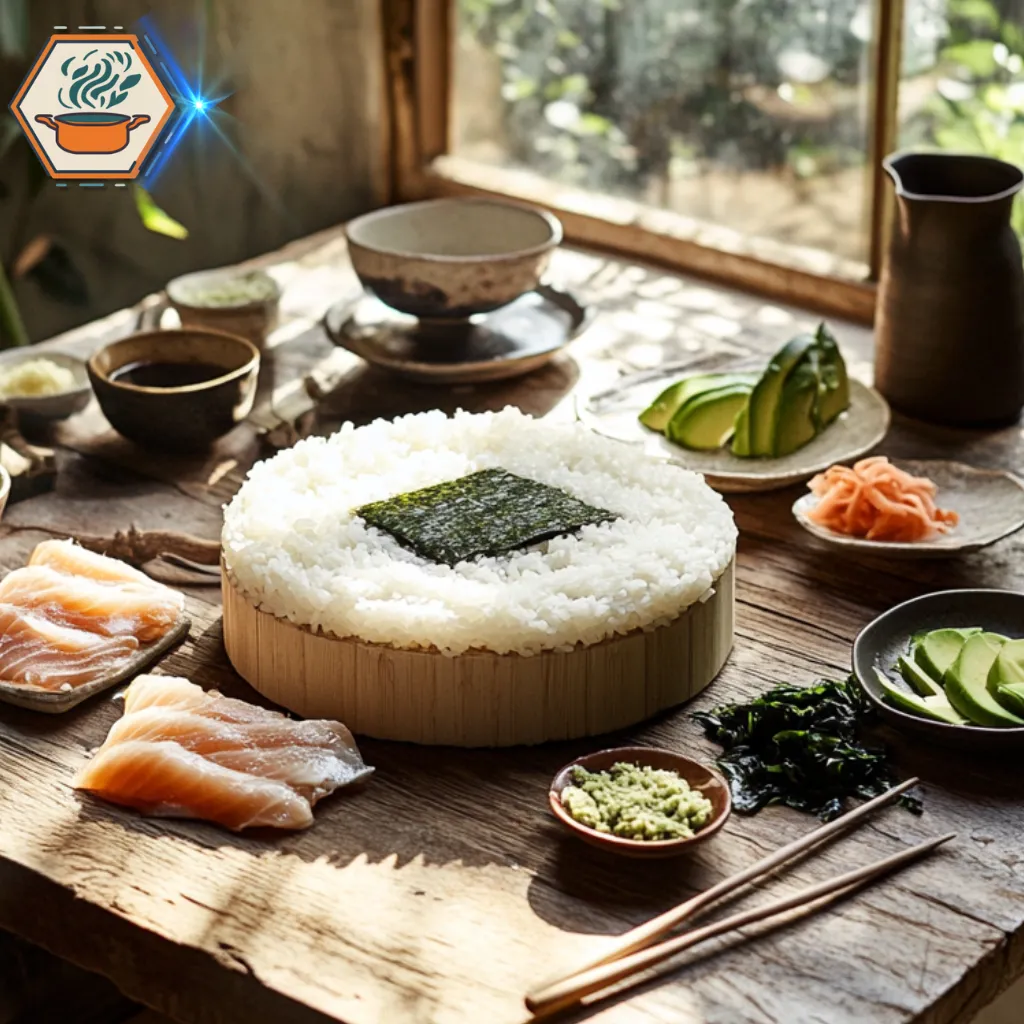
1. Preparing the Rice
Rice is the foundation of any sushi cake. To achieve the best results, follow these steps:
- Select sushi rice: Short-grain rice works best due to its sticky texture.
- Rinse thoroughly: Wash the rice under cold water until the water runs clear. This removes excess starch, which can make the rice too sticky.
- Cook the rice: Use a rice cooker or follow the stovetop method for perfect results. The rice-to-water ratio is typically 1:1.2.
- Season the rice: Mix the cooked rice with rice vinegar, sugar, and a pinch of salt for authentic sushi flavor. Let it cool to room temperature.
2. Layering Ingredients
The magic of a sushi cake lies in its colorful and flavorful layers. Here’s how to create them:
- Base layer: Begin with a layer of sushi rice, pressed firmly into the mold.
- Fish layer: Add thin slices of sashimi-grade fish, such as salmon or tuna, over the rice.
- Vegetable layer: Use sliced avocado, cucumber, or carrots for a burst of freshness.
- Repeat layers: Alternate between rice, fish, and vegetables, depending on the height you want for your cake.
👉 Note: Use cling film to line the mold for easy removal and maintain clean edges.
3. Shaping and Assembling
Shaping the sushi cake is a straightforward process:
- Use the mold: Pack each layer tightly into the mold to ensure the cake holds its shape.
- Refrigerate briefly: Chill the assembled cake for 10-15 minutes to firm it up.
- Unmold carefully: Lift the cake out of the mold by gently pulling on the cling film.
Tips for Perfecting the Aesthetic Appeal
Presentation is key when it comes to sushi cakes. Here are some tips to ensure your dish looks stunning:
- Garnish thoughtfully: Top the cake with edible flowers, sesame seeds, or finely chopped green onions.
- Slice neatly: Use a sharp knife to cut clean portions. Dipping the blade in water between cuts prevents sticking.
- Add sauces artistically: Drizzle soy sauce, spicy mayo, or unagi sauce in decorative patterns for extra flair.
Variations of Sushi cake recipe
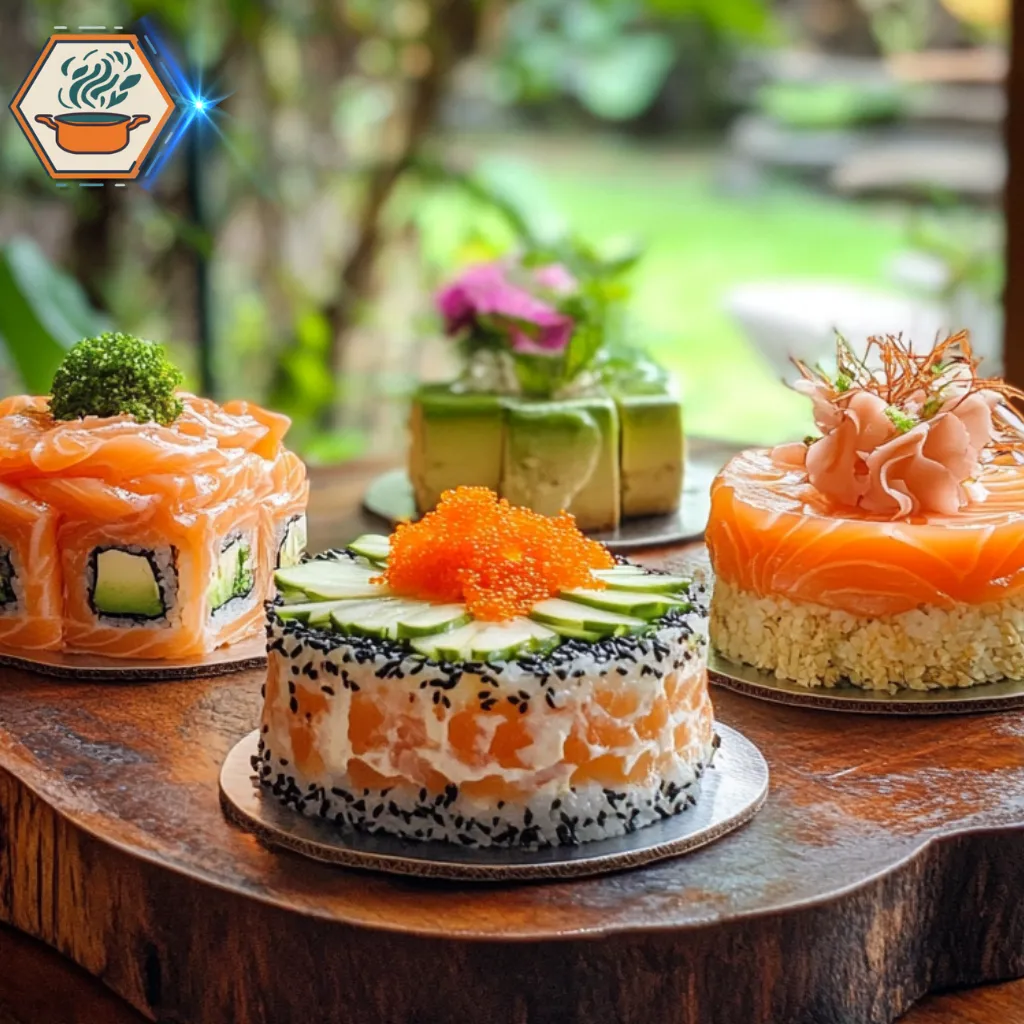
Vegan and Vegetarian Options
Creating sushi cakes for vegans and vegetarians is easier than you might think. Instead of traditional fish or seafood, you can substitute with:
- Avocado: A creamy, nutrient-rich alternative.
- Pickled Vegetables: Like radishes or carrots for crunch and vibrant colors.
- Tofu or Tempeh: Marinated to mimic umami flavors.
- Edamame or Peas: For added texture and protein.
Seaweed salads or flavored nori sheets can add that signature ocean taste. Check out our What is Vegan Chorizo Made From? guide for inspiration on using plant-based ingredients creatively.
Regional Flavors and Unique Twists
Different regions bring their flair to Sushi cake recipe. Some ideas to explore include:
- Hawaiian-Inspired Sushi Cakes: Featuring pineapple chunks and tropical flavors like macadamia nuts or coconut flakes.
- Korean-Style Sushi Cakes: Incorporating gochujang (spicy red chili paste) and kimchi for a bold, tangy kick.
- Southeast Asian Influences: Add mango, mint, and a hint of chili for a fresh and spicy twist.
Regional twists allow for endless experimentation, making your sushi cakes stand out.
Japanese-Inspired Styles
Traditional Japanese flavors are essential for authenticity. Use ingredients like:
- Pickled Plum (Umeboshi): For a tangy surprise.
- Shiso Leaves: A fragrant herb with a slightly citrusy taste.
- Bonito Flakes: For smoky umami layers.
Combine these elements for a traditional yet elegant sushi cake. Learn more about authentic techniques in our Master Caramelizing Sugar article, which shares tips transferable to Japanese cooking.
Fusion Ideas from Other Cuisines
Get creative by blending sushi cakes with global cuisines:
- Mexican Fusion: Add guacamole, jalapeños, and tortilla chip layers.
- Italian Twist: Incorporate ingredients like basil, mozzarella, and sundried tomatoes.
- Middle Eastern Influence: Use tahini, sumac, and falafel crumbles for a unique spin.
Fusion ideas provide a fresh perspective while keeping sushi cakes appealing to broader tastes.
The Role of Sauces and Seasonings
Sauces and seasonings are the finishing touches that transform your sushi cake. Options include:
- Soy Sauce Variants: Regular, sweet, or low-sodium soy sauce for seasoning layers.
- Spicy Mayo: Made with sriracha for heat and creaminess.
- Ponzu Sauce: A citrusy alternative for a refreshing flavor.
- Sesame Oil Drizzle: Adds depth and aroma.
Top your creation with a sprinkle of toasted sesame seeds or freshly chopped scallions for a polished presentation.
Serving and Storing Sushi Cakes
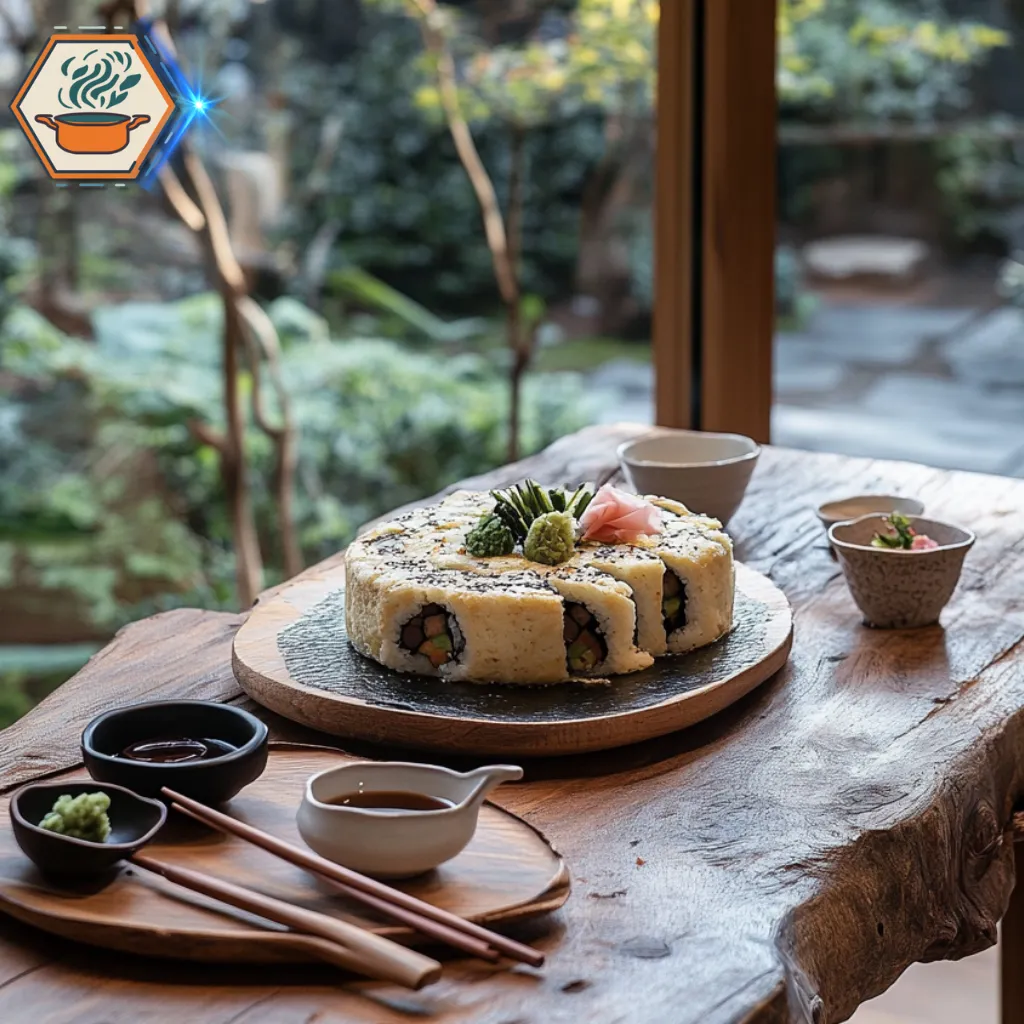
Sushi cakes are a creative twist on traditional sushi. To enjoy them fully, serving and storing them properly is crucial. Below, you’ll find tips for serving, pairing with side dishes, and safely storing leftovers.
Best Ways to Serve Sushi cake recipe
- Presentation matters: Arrange sushi cakes on a flat platter to highlight their layers. Add garnishes like sliced avocado, sesame seeds, or thinly sliced cucumber to enhance the visual appeal.
- Slice with care: Use a sharp knife, dampened with water, to make clean slices. This prevents sticking and maintains the cake’s neat layers.
- Serve fresh: Sushi cakes taste best when served immediately after preparation. The rice and toppings retain their texture and flavors.
💡 Pro Tip: For an elevated experience, serve sushi cakes with homemade sauces such as spicy mayo or teriyaki glaze.
Pairing Sushi Cakes with Side Dishes
Complement your sushi cake with the right side dishes to balance the meal. Here are some great ideas:
- Miso Soup: The warm, umami-rich broth contrasts well with the cool sushi cake.
- Seaweed Salad: Adds a refreshing crunch and complements the cake’s flavors.
- Edamame: Lightly salted soybeans offer a simple yet satisfying accompaniment.
- Pickled Ginger: Cleanses the palate between bites, enhancing each flavor.
Transition words: Furthermore, another excellent pairing is crispy tempura vegetables, which add texture.
Curious about what makes tempura rolls special?
How to Store Leftovers Safely
To maintain the quality of your sushi cakes, follow these storage tips:
- Refrigeration: Place leftovers in an airtight container. Cover them with plastic wrap to prevent the rice from drying out.
- Consume quickly: Sushi cakes should be eaten within 24 hours for the best taste and safety.
- Avoid freezing: Freezing alters the texture of the rice and toppings, resulting in an unpleasant experience.
Transition words: Additionally, ensure proper refrigeration temperatures to minimize bacterial growth.
💡 Pro Tip: Label your container with the date to avoid keeping leftovers for too long.
Frequently Asked Questions about Sushi cake recipe
1. Can sushi cakes be made ahead of time?
Yes, but they are best assembled shortly before serving to maintain freshness.
2. What toppings work well for sushi cakes?
Common toppings include sashimi, avocado, cucumber, and crab meat. Vegetarian options like tofu and roasted vegetables are also excellent.
3. Are sushi cakes gluten-free?
Most sushi cakes are gluten-free if you use tamari instead of soy sauce and avoid imitation crab meat, which may contain gluten.
4. How do I prevent rice from sticking when slicing?
Dampen your knife with water before each cut to avoid sticking.

